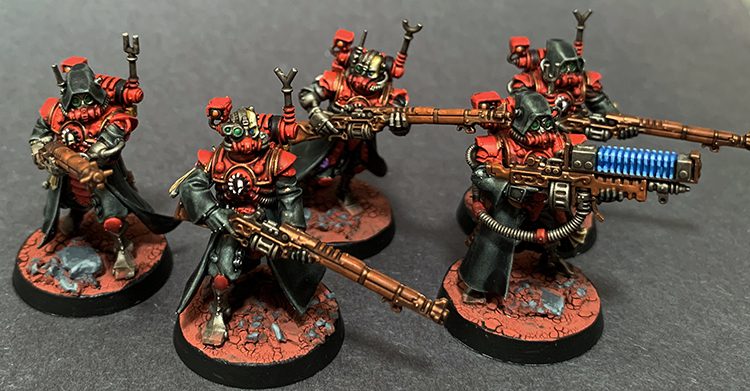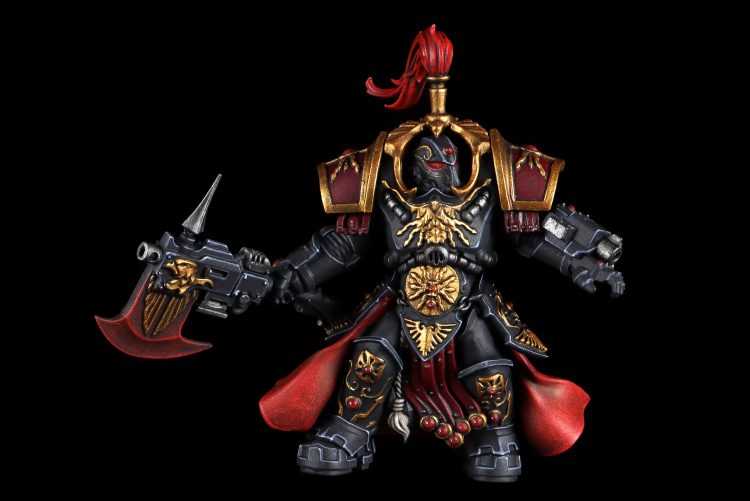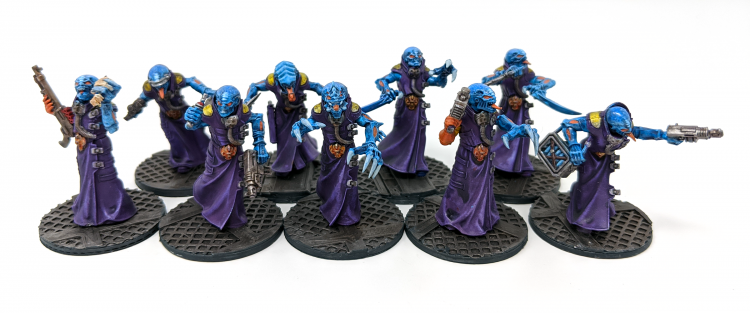Last week Primaris Kevin took a break so he could focus on getting terrain ready for the upcoming US Goonhammer Open. This week we’re back, and Hammer of Math takes a look at the core attack and defense system behind the new edition of Kill Team.

As befitting a skirmish game, Kill Team uses a more nuanced system than 40k when it comes to combat. Instead of the traditional “I Go, You Go” system where one player rolls dice in sequence and then the other player rolls their saves to see who survives, Kill Team uses an opposing dice mechanic where players use successes and critical successes to counter each other. The basic attack sequence for ranged combat is as follows:
- The attacking player rolls a number of dice equal to the Attacks characteristic of their weapon. This ranges from 2 to 6, but is usually between 3 and 4.
- The attacking player compares the result of each die to the Ballistic skill value of the attack, which ranges from 2+ to 5+. Each roll that is equal to or better than the target number is a success (hit). Each roll that equals a 6 is a critical success (critical hit).
- The defending player rolls a number of dice equal to the Defence characteristic of the model, which is almost always 3 before modifiers.
- The defending player compares the results of each die to the Save value of the model, which ranges from 2+ to 6+. Each roll that is equal to or better than the target number is a success (save), each roll that equals a six is a critical success (critical save).
- The defending player then uses their save results to cancel out the incoming hits. A single hit can be cancelled by a single save or a critical save, while a critical hit requires either two saves or a critical save to be nullified.
- The remaining hits and critical hits apply damage to the target; generally critical hits do more damage than regular hits. Some critical hits will do mortal wounds outside of this whole sequence, but we’re ignoring those for now.
Melee combat is also a contested roll, but instead of applying attacks versus defense both players roll attack dice and then alternate between use one dice to attack (deal damage to the opponent) or parry (cancel an opponent’s die). There are a lot of things to balance and investigate here, but we can look at the core probabilities as a binomial probability. We covered this previously in the Expedited Martyrdom article, but fundamentally the binomial probability is the probability that a given number of successes will occur in a given number of trials. For the purpose of Kill Team we’re interested in the probability of at least a given number of successes; more is always better. The tables below provide the distribution of probability for the different combinations of dice and targets available.




To use these charts, start with the target value chart that applies to your success number (WS, BS, or Save) and then look at how many rolls you’ll get on the left. Then go across the row to find the probability that you’ll get at least that many successes and critical successes. For example, a Custodian Guard with a 2+ save and a Defence value of 3 has an 87% chance of getting 3 successes, and there’s a 42% chance that at least one of those rolls will be a critical. Using a Guardian Spear that same Custodian Guard’s 5 attacks with a 2+ to hit translate to a 40% chance that every attack will hit at 5 damage each. You can also use the chart to examine the effect of the Lethal trait, which improves the probability of a critical hit. For example the Guardian Spear is Lethal 5+, which means that critical hits occur on a 5+ and for those 5 attacks you will get at least two successes 54% of the time.

When to Use Cover
We can immediately establish a set of expectations for how Defence rolls will turn out. Since nearly every unit rolls 3 dice for defense we see that on average a 2+ save will generate 3 successes, a 3+ and 4+ will generate at least 2, and a 5+ will generate at least 1. The defender also has the option to use cover, which allows them to turn one die into an automatic normal success prior to rolling and then roll the remainder. This is advantageous because the defender can see the results of the attack before they choose to apply cover. If the attacker manages to get a critical success it may be worth not rolling cover in the hopes of getting a critical success of your own.
For example, let’s say that an incoming attack is dealing 1 critical hit and 1 normal hit. The defending player gets to roll 3 dice and has a save value of 2+. In order to mitigate the attack the defender either needs to roll 1 success and 1 critical success, or roll 3 successes. Should they take cover? The probability of getting 3 successes is 58%, the probability of getting 3 successes if one dice is converted using cover is 69%, and the probability of getting at least one critical success is either 42% on three dice or 31% on two dice. In this case it’s in the best interest of the defender to use cover; relying on the critical hits is less likely to work than trying to get 3 normal successes.
But what if the defending operative’s save was only 5+? In this case the chance of getting 3 successes on 3 dice is 4%, while the chance of getting one critical and one success is only 11% (the 26% chance of getting at least 2 successes multiplied by the 42% chance that at least one of those successes is critical). In contrast the chance of getting one critical on 2 dice is 31%, which when combined with the guaranteed success from using cover makes it the superior choice. On the other hand dealing with multiple incoming critical hits may leave a model with no choice but to abandon the safety of cover in order to attempt the longshot odds of multiple critical saves.
Custodes Invulnerable Saves
Many weapons have an Armour Penetration (AP) ability, which reduces the Defence characteristic of the defender. Note that unlike in 40k armour penetration does not affect the target’s Save value, only the number of dice being rolled. In the case of Custodes they have the option to use a Storm Shield, which provides a 4+ invulnerable save and also allows you to force two successful hits to be discarded when the weapon parries. Invulnerable saves are very powerful in Kill Team because they ignore modifiers to Defence value, which is important when you’re only rolling three dice to start. The question is this; is saving on 3 dice with a 4+ better than saving on 2 dice with a 2+? Using the chart we see that 3 dice will provide at least 2 saves 50% of the time, and get at least one critical 42% of the time. In contrast the 2 dice at 2+ will get those 2 saves 69% of the time, but the probability of getting at least one critical is 31%. Given how close the numbers are, and how important ranged combat is, going for the Guardian Spear might make more sense.

More Teams to Kill
There’s a lot more to cover in terms of Kill Team. In the future we may take a look at the influence of weapon abilities, the difference between ranged and melee combat, and also pit some units against each other to see how they turn out. In the interim I hope you found this article to be a good introduction to the core mechanics of the game, and are as excited as I am to try it out. Thanks for reading! If you have any feedback, feel free to drop a note in the comments below or email us at contact@goonhammer.com. If you have any questions that you would like answered in a future article like this one, please submit them here.


